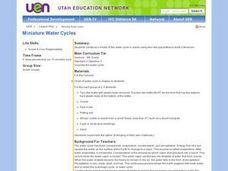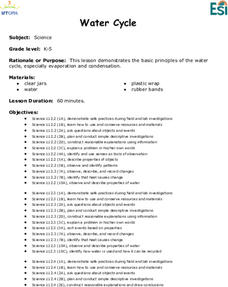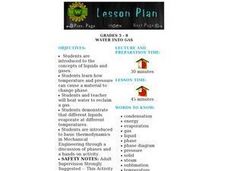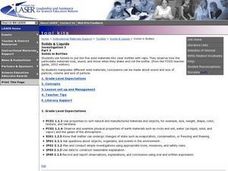Curated OER
How Do You Dew?
Young scholars examine how the processes of condensation and evaporation occur. They describe the relationship between heat energy, evaporation and condensation of water on Earth. They give examples of the processes of evaporation and...
Curated OER
Physical Changes and States of Matter
Fourth graders study evaporation and condensation as parts of the water cycle. First they determine the similarities and differences between a cup of water and an ice cube before measuring the volume of ice before melting it, and...
Curated OER
Condensation and the Water Cycle
Students explore the natural distallation process that occurs in the water cycle. They use plastic cups and cotton swabs to observe the condensation process that is evident in the water cycle.
Curated OER
The Rain Maker
Second graders work in small groups with a cup each of several materials. Students layer the gravel, sand, and water into a resealable bag. They draw a picture of this bag in their water journal. Students place their sealed bags in a...
Curated OER
Here it Comes Again
Second graders work in small groups with on cup each of warm and ice water. They observe the outsides of the cups. They exhale onto a small piece of mylar or mirrors and discuss the change in appearance. Students discuss where the foggy...
Curated OER
The Water Cycle
Students describe the water cycle. Students identify the processess in the water cycle. They draw an illustration of the water cycel with arrows showing the path water takes through the cycle. Students label condesation, precipitation,...
Curated OER
Weather and the Water Cycle
Second graders discover the causes of different types of weather. They draw pictures of the water cycle steps and answer worksheet questions. Students observe teacher-conducted demonstrations exemplifying condensation and evaporation.
Curated OER
Weather or Not (Cloud Formation/Condensation)
Students investigate the formation of clouds and rain in this experiment. They decide how dust in the air helps to make clouds form and how dust helps meteorologists make forecasts.
Curated OER
Meteorology (Condensation)
Second graders define condensation and evaporation. They identify and describe the steps in the water cycle. They ask questions to end the lesson.
Curated OER
Rain, Rain, Go Away
Students conduct a number of experiments involving evaporation and condensation. They view and discuss a video about the water cycle and then design posters about the rain based on the book "Cloudy With A Chance of Meatballs".
Curated OER
Miniature Water Cycles
Fourth graders create a biome of their choosing in a terrarium. Terrariums are observed and results recorded daily for 2 weeks. They observe/record changes in the water within their terrarium and use the data to write sentences...
Curated OER
Earth: The Water Planet
Students elicit data on the water cycle, ocean topography, and island formation in this six lesson unit. The ocean floor and the properties of water are examined through a variety of discussions and hands-on experiments.
Curated OER
Water Cycle
Students perform experiments with water to observe the principles of evaporation and condensation. They make models of the water cycle and discuss the processes that occurred in their experiments with their jars of water.
Curated OER
Water Into Gas
Students investigate how temperature and pressure cause a material to change phase. They heat water to reclaim a gas. They demonstrate that different liquids evaporate at different temperatures.
Curated OER
The Atmosphere and Flight
Students investigate evaporation and condensation, and apply the concepts to understanding cloud formation.
Curated OER
Condensation Lab
Students investigate condensation in the lab. For this chemistry lesson, students explain molecular motion during phase changes. They relate this observation to Earth's weather conditions.
Curated OER
Evaporation and Condensation
Young scholars explore how temperature effects the processes of evaporation and condensation and how the air may be polluted by the evaporation of certain compounds. For this temperature lesson students complete a lab and a...
Curated OER
How Do Nitrogen and Water Cycle?
In this nitrogen and water cycle worksheet, students will brainstorm a main idea about the nitrogen cycle or the water cycle. Then the student will write in three details that support their main idea.
Curated OER
All About Matter
In this chemistry worksheet, students locate twenty seven terms in a word search. Answers to the puzzle are available in various formats.
Curated OER
Gases, Liquids And Solids
Students investigate how gases are different from solids and liquids and that they can evaporate and condense. They observe water boiling in a teapot and discuss what happens when the steam touches a cold window, complete an online Heat...
Curated OER
The Water Cycle
Third graders observe that water travels in a cycle. They study the parts of the water cycle: evaporation, condensation, and precipitation. They demonstrate the cyclical movement of water either by drawing the water cycle at the board,...
Curated OER
Clouds and Rainfall
Students use the general climate section of the Digital Atlas of Idaho.
Then they identify and interpret some basic concepts about climatology. Students also read through the information contained in the Digital Atlas on Climatology....
Curated OER
Solids in Bottles
Learners use funnels to put the five solid materials into clear bottles with caps. They observe how the particulate materials look, sound, and move when they shake and roll the bottle. Finally, students write "sound and touch" poetry.
Curated OER
Floating Candles
Students observe a combustion reaction and deduce the components necessary for the reaction to occur. They also identify and interpret the relationship between pressure, volume, and number of molecules for gasses. Finally, students use...

























